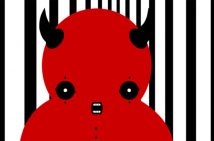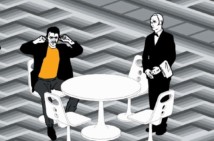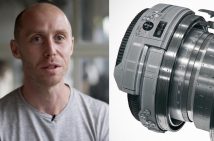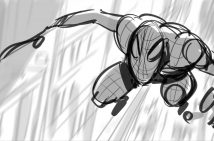Submarine Channel

Interview with Fons Schiedon
Interview with Fons Schiedon
Submarine Channel and Fons Schiedon go way back. Did you know that he animated the very first interactive animation on SubmarineChannel: ‘The Killer’? And when the channel needed a new look with enhanced features we called upon him again to wield his uber-talented skills and give us an extreme make-over, FonzTV style. Fons also worked on the motion graphics of Submarine’s documentary ‘Sneakers’. Yes, the man is a busy bee, and he seems to live and breath character designs. We love all his creatures: Monki, Squirrel and The MobSquad (“dysfunctional behaviour is their main activity”). The cherry on top of this lil’ interview has to be Fons’ lovely scribbles and sketches.
Since the mid-ninetees the demand for cutting-edge animation has been increasing – both from the audience and from the commercial world. Can you explain this?
I believe there are two things that you can see happening from that time untill now. One is that the interest in ‘drawn’ images becomes popular in the commercial world. This I think is something that happens in waves. Now we happen to be in a period where illustration and animation is very popular. This was a bit different five years ago, it was much more about photography then. And it will be different five years from now. Another thing is that the tools to produce digital content of a high standard have become very accessible since the mid nineties. Making a commercial or music video doesn’t have to require more than a laptop. Next to that, you see that the appreciation for desktop produced content is increasing. Commercial clients are eager to find fresh content to wake up their increasingly bored consumers, and choose to hire small independant designers and artists, working from small studios or their bedrooms. Viewers get used to that, and learn to love it. On one side viewers are becoming very picky about the level of realism in the hollywood animation blockbusters – consumers criticizing animation technique!, pretty crazy. On the other side, a short animation someone made in two weeks using Flash could count on widespread appreciation.
In Hollywood movies it was a trend for a while to constantly improve the photo-real cg stuff. Almost like an obsession. One horrible disaster movie after another. People lost interest in this obsession, also because the point of photo realism is simply reached, or we don’t care anymore. Just stop testing your rendering skills on a paying audience! Now there seems to be a slightly increased interest in storytelling again, which is nice.
Original good stories are hard to find. That’s why Hollywood keeps on recycling the old classics such as King Kong, Romeo and Juliet. Are there any classic stories that you would like to work with?
Interesting question, I was surprised to see Miami Vice made into a feature film. I guess the A-team will be next. One story that has had a big influence on me, at least visually, was Winsor McCay’s Little Nemo in Slumberland. It’s difficult to imagine a better way to approach that story, so perhaps it’s wise to stay away from it. On the other hand, a story like that can be a great starting point to create something of a similar richness from a contemporary perspective. I’ve always loved how Frank Miller treated the Batman concept in his Dark Knight Returns book. He just took the core idea and placed it in a context that couldn’t have been further away from Bob Kane’s original treatment. Everything skewed and twisted, and yet being the most ultimate of interpretations. In my opinion.
Do you have a favourite movie?
I don’t know. Is A Space Odyssey a better film than Lost In Translation or Gummo? Maybe. I just saw Matthew Barney’s Drawing Restraint 9. Like his other work, beautiful and fascinating. Not my favorite of his works, but yet another unique mesmerizing collection of images from a genuine visionary.
Have you ever been to Tokyo?
I’ve never been to Japan. I want to go.
I’m asking because your stuff is quite ‘kawaií’ (cute, Japanese style) sometimes.
First I have to say that I’ve been moving away from that kawaii factor in my work, because I don’t want it to become a standard in what I do. It also has become very popular now to use ‘Japanese inspired’ elements, I see it with many other Western designers now, and it’s going the same way as ‘urban’ design the last 2 years. Everything is urban, everything has to have paintdrips, be streetwise blablah. Anyway, cute is okay if it has to be cute, that’s all.
So, what’s the appeal of Japanese design?
For me the biggest appeal of Japanese design would be the lack of consensus. Japanese design has many faces, but there is a great general notion of perfectionism. Or so it appears. Of course, any good design lacks consensus – be it Dutch, Danish or Japanese design, but in Japan it always finds such an extreme shape, and I often find that very beautiful.
The happy violent bugs you did for MTV Asia/Motorolo are pretty extreme too, but on another level (lots of violence!). But they seem to be quite popular in Asia, right?
Yes, in South-East Asia to be precise. But that’s a very different audience than the Japanese. I think these wouldn’t work too well in Japan – perhaps the design, but the animations not so much – too ordinary for them I expect. I could be wrong though.
One of the appealing aspects of your work are your character designs. It seems that Europe and the US are now discovering the potential of character merchandising. What do you think about the use of characters to promote products?
Yes, it’s a rediscovery. Characters used to be more common in advertising. I have the feeling that the success of Pixar has a lot to do with the general appreciation for characters among adults. Anyway, I think it’s alright. Why not? As with everything, it results in a lot of crap and a couple of jewels. And if companies get so excited that they flood the market with soulless crap, we will all get sick of it soon enough. This could be one of these advertising waves again. But there’s something interesting about characters in Asia, that is now quickly spreading to Europe and the US, that is, characters without a background. No supporting series or comic, not a merchandise item, but just the character for their own sake. We’ve been familiar with mickey mouse and his contemporary colleague spongebob – all supported by tvseries and commercial legacy, but now we’re also prepared to pay for figurines for the same reason as why previous generations paid for bronze sculptures. As objects.
How do you work? Do you just start drawing, or do you have the whole concept lined out?
The concept is always there, but how exactly it’s going to be translated into an image, that’s a matter of just designing. I’ve been asked this question some times before, and it’s funny, because that question typically applies to illustration. With graphic design it’s more common to find the final shape in the design process, but illustrators are expected to make a draft version first and then kind of colorize their own sketch. That’s heritage. I don’t sketch, unless I need it to convince a client.
Making the image is a matter of starting with nothing and making things, and then moving those things around until it’s done. It can be in the computer, but it can be anything else as well.
So, what comes first. The story or the animation?
The story or idea has to come first. It can be a fully storyboarded story or just a vague idea, but I can’t start on anything without at least a notion of what I’m looking for. As for animation, because I only do client work, it’s often necessary to give a good impression of what they can expect. Especially when I’m aiming for something I haven’t done before. At least I do a written treatment, at most a full animatic.
Do you feel like you have enough creative freedom with your client work to do what you want?
Working with clients means that you’re always dealing with requirements and limitations of budget and time. That’s the deal. So compared to working as an artist, that’s a restriction of your freedom. But I don’t know what it’s like to be completely free, I just know about working with a briefing and work out something that has a certain use. That’s a process that involves proposals, directions from both sides and changes in the design. As long as I can relate to the decisions that are made, there’s no real restriction of any creativity. Perhaps it means that I can’t always make everything purple, but I think that is a good thing. To answer your question. The clients I work with now don’t force me to take directions I can’t support, so it’s a great situation.
In terms of work, what are your greatest ambitions?
There’s only the ambition to do interesting work. That sounds very simple – but that’s how it is. Practically that means that I need interesting clients, and I have no complaints at this time. Besides that I think it will be great fun to decorate a complete amusement park some day.
Fons is now working on a very exciting animation project called Kika & Bob. The project is still shrouded in mystery and under embargo, but as soon as we have more info and pictures, you’ll hear from us. Meanwhile…
Loads more artwork, videos and assorted goodness on www.fonztv.nl



